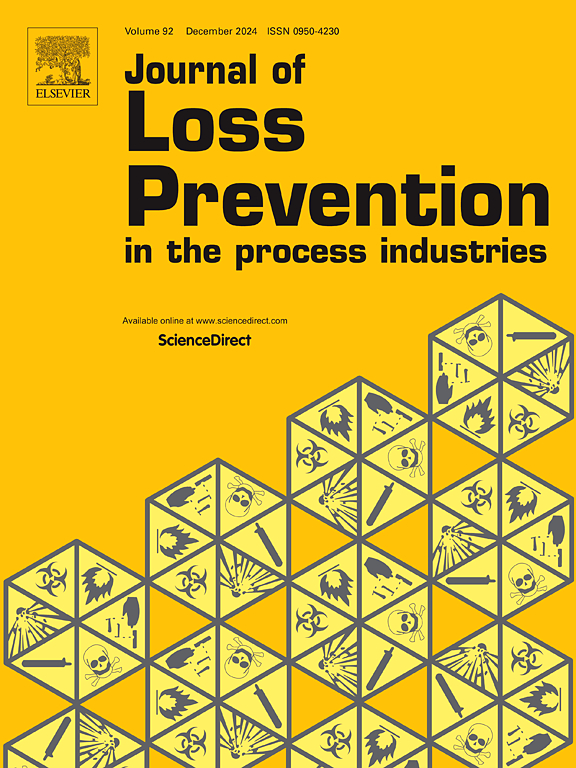研究了随机填料对火焰淬火和爆炸压力抑制的影响
IF 4.2
3区 工程技术
Q2 ENGINEERING, CHEMICAL
Journal of Loss Prevention in The Process Industries
Pub Date : 2025-06-13
DOI:10.1016/j.jlp.2025.105710
引用次数: 0
摘要
气相氧化过程是一种重要的化学反应过程,广泛应用于各种原料、中间体和产品的生产。由于这些反应中的原料主要由可燃气体组成,因此在反应物中存在一定浓度的氧会导致可燃系统的形成。在这种情况下,点火源可能引起爆炸,对人员和设备构成严重的安全风险。创新性地提出了采用多孔惰性无规填料扑灭丙烯-空气火焰的方法,并利用自制爆震管研究了不同类型多孔惰性填料扑灭火焰和降低最大爆炸压力的性能。结果表明:在直径为20 mm的管道中,在110 kPa和160 kPa的压力下填充随机填料,可以有效地将8% c3h6 - 92%空气预混气体的火焰在20 cm内淬灭。拉希环填料可将火焰淬火距离控制在5厘米以内。当预混合气体的初始压力为110 kPa时,Dixon环填料的实施使最大爆炸超压相对于空腔结构降低了13.3%。此外,还考察了氢气对火焰淬火距离和爆炸压力升的影响,与C3H6-9air预混气相比,火焰淬火距离和爆炸压力升均有所增加。另外,Pall环的随机填充由于孔隙率大,不能淬灭加氢预混气体的火焰,导致壁效率较差。这些实验结果为开发新型本质安全气固相反应器提供了理论支持和指导,并为在爆炸极限范围内进行气相氧化反应提供了策略。本文章由计算机程序翻译,如有差异,请以英文原文为准。
Investigating the effect of random packing on flame quenching and explosion pressure suppression
Gas-phase oxidation processes are crucial chemical reaction processes widely utilized in the production of various raw materials, intermediates, and products in several industries. Due to the fact that the raw materials in these reactions primarily consist of flammable gases, the presence of a certain concentration of oxygen in the reactant leads to the formation of a combustible system. In such cases, ignition sources can cause explosions, posing serious safety risks to personnel and equipment. In this study, the use of porous inert random packing to quench propylene-air flame was innovatively proposed, and the performance of various types of porous inert packing in extinguishing flames and reducing the maximum explosion pressure was also investigated by self-made detonation tube. The results show that the flame of 8 % C3H6-92 % air premixed gas can be effectively quenched within 20 cm by filling the random packing in a pipe with a diameter of 20 mm at the pressure of 110 kPa and 160 kPa. Raschig ring packing can control the flame quenching distance within 5 cm. When the initial pressure of premixed gas is 110 kPa, implementation of Dixon ring packing achieves a 13.3 % reduction in maximum explosion overpressure relative to the empty chamber configuration. In addition, the effects of hydrogen on flame quenching distance and explosion pressure rise were also performed, and the flame quenching distance and explosion are all increased compared with the system of C3H6-9air premixed gas. Furthermore, the random packing of Pall rings cannot quench the flame of premixed gas with hydrogen addition because of its large porosity which leads to poor wall efficiency. These experimental findings provide theoretical support and guidance for the development of new types of intrinsically safe gas-solid phase reactors and offer a strategy for conducting gas-phase oxidation reactions within the explosive limit range.
求助全文
通过发布文献求助,成功后即可免费获取论文全文。
去求助
来源期刊
CiteScore
7.20
自引率
14.30%
发文量
226
审稿时长
52 days
期刊介绍:
The broad scope of the journal is process safety. Process safety is defined as the prevention and mitigation of process-related injuries and damage arising from process incidents involving fire, explosion and toxic release. Such undesired events occur in the process industries during the use, storage, manufacture, handling, and transportation of highly hazardous chemicals.

 求助内容:
求助内容: 应助结果提醒方式:
应助结果提醒方式:


